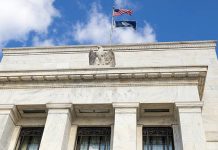Summary
- The Bank of Japan (BoJ) sprung a mild surprise at today’s announcement, raising its policy rate to around 0.25%, from around 0% to 0.1% previously. The BoJ also said it would reduce the pace of its bond purchases to around ¥3T per month by early 2026. The BoJ’s accompanying comments leaned hawkish in tone, and suggested further tightening would likely be forthcoming.
- Given the central bank’s apparent willingness to look through subdued activity data, and apparent desire to front load policy normalization, we now forecast faster BoJ rate hikes than previously. We see another 25 bps rate hike to 0.50% in October, while we also now forecast a further 25 bps rate hike to 0.75% in January 2025.
Bank of Japan Delivers Monetary Tightening, Signals More To Come
The Bank of Japan (BoJ) sprung a mild surprise on markets, delivering an earlier than expected rate increase. The central bank also announced a reduction to its monthly bond purchases, though perhaps a slightly more gradual pace of bond purchases than anticipated. Specifically, the BoJ:
- Raised the target for the uncollateralized overnight call rate to around 0.25%, from around 0% to 0.1% previously.
- Signaled it would reduce the pace of its monthly bond purchases by around ¥400B every quarter, to just under ¥3T per month by early 2026.
For August-September 2024, the BoJ said bond purchases would be ¥5.3T per month, and with regular ¥400B reductions each quarter, fall to ¥2.9T per month by Q1 2026. The central bank said it would conduct an interim review of its bond buying plan in June 2025, and in the case of a rapid rise in long term bond yields, respond nimbly, including for example, increasing its purchases.
In addition to the surprise rate hike, the BoJ’s announcement and Governor Ueda’s post-meeting press conference were notable for several hawkish leaning comments:
- Real interest rates are expected to remain significantly negative after the change in the policy interest rate, and accommodative financial conditions will continue to firmly support economic activity.
- If the outlook for economic activity and prices evolves broadly as expected, the central bank will accordingly continue to raise the policy interest rate and adjust the degree of monetary accommodation.
- Import price inflation has turned positive and upside risks to prices require attention.
- Wage increases have been significantly higher than last year, and have been spreading across regions, industries and firm sizes.
- FX developments are more likely to affect prices than in the past.
- Governor Ueda said another rate hike before year-end was data dependent. Asked about the terminal level of the BoJ’s policy rate, Ueda said 0.50% was not considered a particular limit.
With respect to its outlook on price pressures, the Bank of Japan lowered its core inflation forecast for fiscal year 2024 to 2.5% (from 2.8% previously) and increased its forecast for fiscal year 2025 to 2.1% (from 1.9%). The BoJ kept its forecast for core inflation for fiscal year 2026 unchanged at 1.9%.
We see a couple of important takeaways from today’s announcement. First, the BoJ appears to be willing to discount subdued economic activity to some extent, given recent weakness in GDP and some other activity data. That suggests that wage and inflation data will remain particularly important for the timing and magnitude of further rate increases. Second, it also appears possible the BoJ is to some extent trying to front load rate increases, such that the Bank of Japan makes progress in normalizing monetary policy ahead of the significant and sustained monetary easing that is anticipated from the Federal Reserve.
Against this backdrop, we now expect earlier and more pronounced rates hikes from the Bank of Japan than previously. We forecast the next 25 bps policy rate hike to 0.50% at the October monetary announcement, a rate hike that will likely be supported by continued firmness in wages and inflation. We also forecast another 25 bps rate increase to 0.75% at the January 2025 announcement. We acknowledge, however, that this 2025 rate increase is less certain, depending on how price trends evolve and whether the BoJ’s cumulative rate increases have a more meaningful impact in restraining the economy. Beyond that, we expect the BoJ to hold its policy rate steady through the rest of 2025. Given our outlook for faster Bank of Japan tightening, and ongoing easing from the Federal Reserve over time, we believe conditions remain in place for the yen to strengthen through much of 2025.













